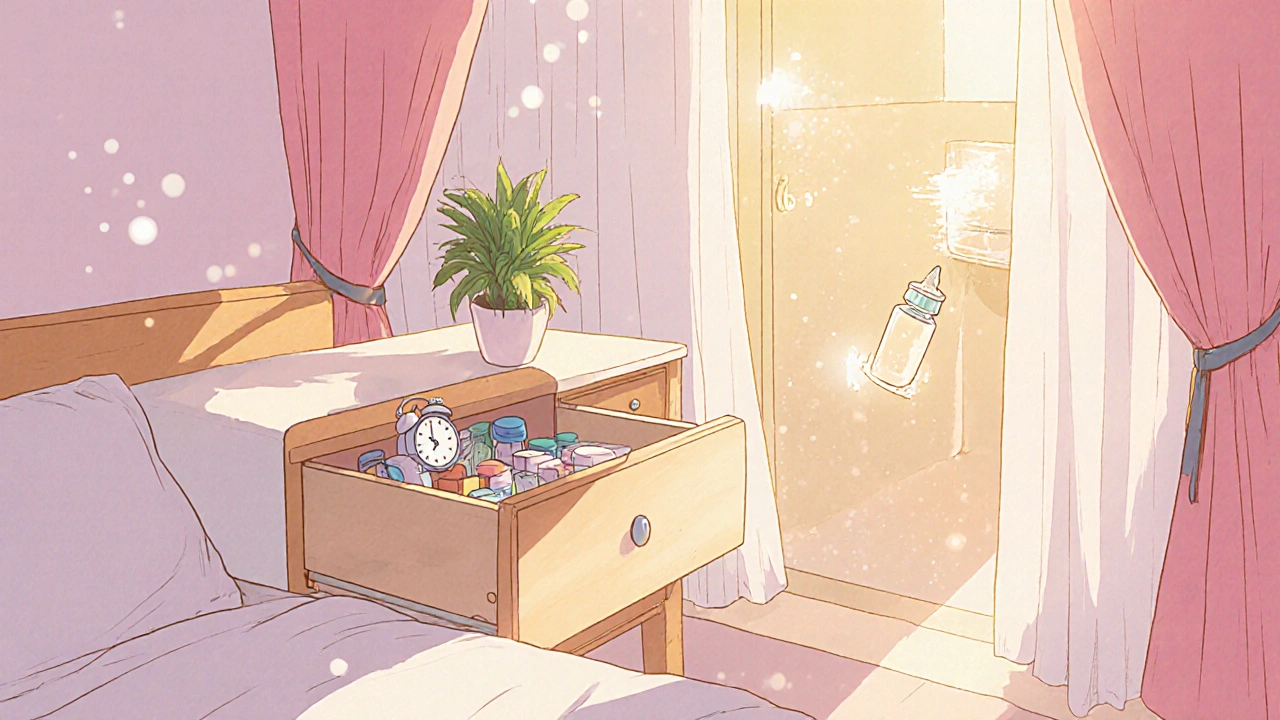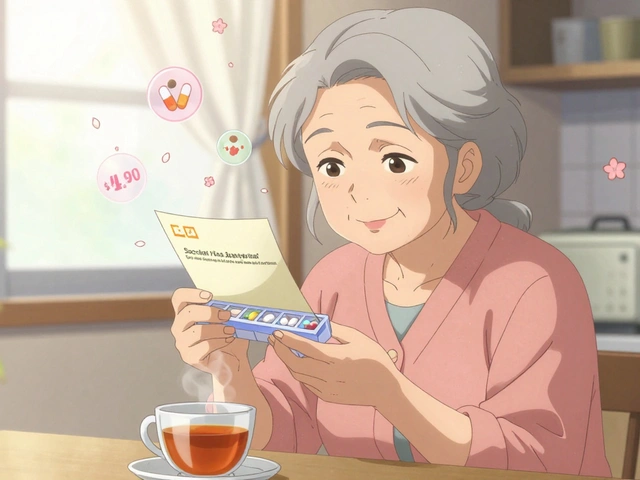
Most people keep their medications in the bathroom. It’s convenient - right next to the sink, easy to grab in the morning, and that little cabinet above the toilet feels like the natural spot. But here’s the truth: storing medications in the bathroom is one of the most common, and dangerous, mistakes you can make with your health.
Why the Bathroom Is a Medication Killer
Bathrooms aren’t designed for medicine. They’re designed for steam, splashes, and hot showers. That’s the problem. Every time you turn on the shower, the temperature spikes. Humidity soars to 80-100%. Moisture clings to everything. And that moisture doesn’t just fog up your mirror - it eats away at your pills, patches, and liquids. Pharmacists like Ramona Stroe from Kaiser Permanente say heat and humidity break down the active ingredients in drugs. Tablets absorb water and start to crumble. Capsules get sticky or brittle. Liquid antibiotics and insulin can lose their strength. Even something as simple as birth control pills can become less effective - studies show potency can drop by up to 35% when stored in damp, warm conditions. It’s not just theory. A study in Circulation found that patients storing beta-blockers in their bathrooms had inconsistent blood pressure control 30.2% of the time. That’s not a small risk. That’s a life-threatening one. If your heart medication doesn’t work because it’s been sitting in steam for months, you could end up in the ER.What Happens to Your Drugs in the Heat and Moisture
Different medications degrade in different ways. Here’s what you need to watch for:- Insulin: It’s a protein. Heat above 86°F (30°C) makes it clump and lose effectiveness. If your insulin doesn’t work, your blood sugar spikes - fast.
- Nitroglycerin: Used for chest pain. This drug is extremely sensitive to moisture. Even a little humidity can make it useless within weeks.
- Antibiotics: If they’ve degraded, they won’t kill the infection. That doesn’t just mean you feel worse - it means bacteria survive, adapt, and become resistant. The WHO calls this one of the biggest global health threats.
- Blood glucose test strips: Not a drug, but critical for diabetics. Humidity causes them to give false readings in 68% of cases, according to the Journal of Diabetes Science and Technology. That means you could be dosing insulin wrong - dangerously wrong.
- Warfarin: A blood thinner. If it loses potency, you’re at risk for clots. If it degrades unevenly, you could bleed internally. Both are deadly.
And it’s not just the pills. Patches, inhalers, and eye drops are just as vulnerable. You can’t see the damage. That’s why it’s so dangerous. Your medication looks fine. It still has the same shape, color, and expiration date. But inside? It’s weak. Or worse - broken.
The Hidden Danger: Kids, Pets, and Theft
It’s not just about potency. Bathroom cabinets are usually unlocked. Open. Easy to reach. The CDC says 70% of misused prescription opioids come from home medicine cabinets. And most of those are in bathrooms. Kids climb on the toilet. Pets jump up. Teens rummage through drawers. If you’re storing painkillers, sedatives, or ADHD meds in the bathroom, you’re putting them within easy reach of someone who shouldn’t have them. A 2022 NIH study found that 80% of U.S. households store meds in easily accessible spots. Of those, 63% had children under 18, and 57% had pets. The American Academy of Pediatrics says all medications should be locked away - not left on the counter or in a cabinet with a flimsy latch. And it’s not just about accidents. People who need drugs for chronic pain or anxiety often end up taking more than they should because the meds are just... there. Easy. Accessible. That’s how dependence starts.
Where You Should Store Medications Instead
The right place is simple: cool, dry, and out of reach.- Bedroom dresser: A drawer away from windows. Temperature stays steady. No steam.
- Closet shelf: Interior closet, not one next to the heater or in direct sunlight.
- Specialized storage box: Some companies now sell airtight, humidity-resistant containers with built-in desiccants. They’re cheap and effective.
Most medications are stable between 59°F and 77°F (15°C-25°C). That’s room temperature. Your bedroom or living room is perfect. Avoid the kitchen too - the fridge door opens often, and the oven heats things up. And never store meds in the car. Summer temps inside a parked car can hit 140°F.
Only a few drugs need refrigeration - about 12% of prescriptions, according to the FDA. That includes insulin, some eye drops, and certain antibiotics. If your drug needs the fridge, keep it in the back, where it’s coldest and most stable. Don’t put it in the door. That’s where the temperature swings the most.
What to Do with Old or Expired Medications
If your meds are old, discolored, cracked, or smell weird - toss them. Don’t flush them. Don’t throw them in the trash where kids or animals can get to them. In Australia, the National Drug Strategy runs take-back programs at pharmacies. Bring your expired or unused meds to any pharmacy - they’ll dispose of them safely. No questions asked. No cost. If there’s no take-back program nearby, mix pills with coffee grounds or cat litter, seal them in a container, and throw them in the trash. This makes them unappealing and unusable. The NIH estimates $98 million worth of unused meds sit in Australian and U.S. homes. That’s not just waste - it’s a public health hazard. Proper disposal protects your family, your water supply, and your community.
How to Keep Track and Stay Safe
Every three months, do a quick audit:- Take everything out of your medicine cabinet.
- Check expiration dates.
- Look for changes: pills that are cracked, powdery, or discolored. Liquids that are cloudy or have particles. Patches that are sticky or peeling.
- Throw out anything questionable.
- Move what’s left to a cooler, drier spot.
Use a pill organizer with compartments for morning, afternoon, and night. That way, you’re not digging through a cluttered cabinet every day. And if you’re on multiple medications, download a free app that reminds you when to take them - and when to check storage conditions.
A 2023 study in the Journal of the American Pharmacists Association found that people who used apps with storage reminders improved their medication habits by 47%. That’s huge. Small changes lead to big results.
What’s Changing - and What You Should Know
Pharmaceutical companies are starting to catch on. More prescription bottles now include storage instructions. Some have humidity-sensitive labels that change color if exposed to too much moisture. Others include tiny desiccant packets inside to soak up dampness. The FDA updated its guidance in 2023 to explicitly warn against bathroom storage. The American Pharmacists Association launched the "Store It Safe" campaign in 2022 and handed out over a million brochures. But awareness still lags behind behavior. A 2023 survey found that 68% of Americans still keep meds in the bathroom - even though 89% know it’s not safe. That gap between knowing and doing is the real problem. You don’t need fancy gadgets. You don’t need expensive storage units. You just need to move your meds.Final Thought: Your Meds Are Only as Good as Their Storage
You take your meds because they’re supposed to help you. But if they’ve been sitting in steam and heat, they’re not helping anymore. They’re just plastic and powder. Moving your medications out of the bathroom isn’t a chore - it’s a safety measure. It’s as important as taking them on time. It’s as important as seeing your doctor. Do it today. Clear out that cabinet. Put your pills in a drawer. Check them every few months. Protect your health - and your family’s.Can I store my medications in the kitchen cabinet?
Only if it’s away from the stove, oven, or sink. Kitchens get hot and humid, especially near the dishwasher or window. A cabinet on an interior wall, away from appliances, is better than the bathroom - but a bedroom drawer is still the best option.
What if my medicine says "refrigerate"?
Keep it in the back of the fridge, where it’s coldest and most stable. Don’t put it in the door. Avoid the freezer - freezing can damage many medications. Always check the label or ask your pharmacist for exact instructions.
Are expired medications dangerous to take?
Most expired meds aren’t toxic, but they lose effectiveness. Taking an expired antibiotic could mean your infection doesn’t clear. An expired EpiPen might not stop a severe allergic reaction. When in doubt, don’t take it. Dispose of it properly.
How do I know if my pills have gone bad?
Look for changes: pills that are cracked, chalky, or discolored; capsules that are sticky or swollen; liquids that are cloudy or have particles; patches that don’t stick well. If it looks or smells off, throw it out. Don’t risk it.
Is it safe to store medications in a locked box in the bathroom?
No. Even a locked box doesn’t protect against heat and moisture. The environment is still unsafe. If you must use the bathroom for storage, move it to a drawer on the other side of the house - but better yet, just move it to your bedroom. The lock helps with safety, but not with potency.
Can I store vitamins and supplements in the bathroom?
Same rules apply. Vitamins like B12, vitamin D, and fish oil degrade faster in heat and humidity. They may still look fine, but you’re not getting the full dose. Store them with your other meds - in a cool, dry place.






There are 15 Comments
Lexi Brinkley
OMG I just moved all my meds outta the bathroom 😱 I had my insulin in there for years… no wonder my sugar’s been all over the place. This post saved my life. 🙏
Edward Weaver
Of course you store meds in the bathroom - it’s America, not some European lab. You think your pills are gonna crumble from a little steam? Nah. You’re just scared of your own shadow. I’ve been doing it since 1998 and I’m still standing. 🤷♂️
Kelsey Veg
ok but like… i always thought the cabinet was fine? i mean my pills still look the same?? how do u even know they’re broken?? 🤔 maybe this is just pharma fearmongering??
Alex Harrison
Just moved my blood pressure meds to the bedroom drawer last week. Didn’t realize how much humidity was messing with them. My readings have been way more stable since. Seriously, if you keep meds in the bathroom, you’re playing russian roulette with your health. Don’t be lazy.
Jay Wallace
Let’s be clear: storing medications in the bathroom is not merely ‘inadvisable’-it’s a catastrophic failure of personal responsibility, a dereliction of basic pharmacological literacy, and a direct affront to the sanctity of therapeutic efficacy. The FDA has issued warnings. The WHO has issued warnings. And yet… you still do it. Why? Because you’re lazy. And you think you’re special. You’re not.
Alyssa Fisher
It’s funny how we trust our bodies to heal with medicine, but we don’t trust ourselves to store it properly. We’ll drive 20 minutes to the pharmacy for a refill, but leave our insulin in a steam room. The real question isn’t where to store it-it’s why we treat our health like an afterthought.
Alyssa Salazar
Humidity-induced degradation of pharmaceuticals is a well-documented phenomenon-especially for protein-based biologics like insulin and monoclonal antibodies. The Arrhenius equation predicts exponential decay in stability under elevated temperature and moisture conditions. Bottom line: your bathroom is a chemical reactor for drug decomposition. Don’t be the person whose EpiPen fails because they thought ‘it still looks fine’.
Beth Banham
I never thought about this until now. I’ve got my vitamins and painkillers in the bathroom. I’ll move them tonight. Thanks for the reminder. 🌿
Amber O'Sullivan
My grandma kept everything in the bathroom and she lived to 97 so maybe its fine
Ankit Yadav
Great post! I’m from India and in our homes, bathroom storage is common because AC is rare. But I’ve started using small airtight containers with silica gel packets. Even cheap ones from Amazon work. Small change, big difference. You don’t need to be perfect-just better than before.
Meghan Rose
Wait so you’re saying I can’t keep my Xanax next to my toothbrush? Like… where else am I supposed to put it? I need it when I panic. And I panic in the shower. So… what now? 😭
Steve Phillips
Let me get this straight-you’re telling me that my perfectly good, perfectly branded, perfectly expensive pills are just… evaporating in the steam? Like some kind of magical pharmaceutical fairy dust? I mean, come ON. This is the kind of fear-mongering that makes people distrust science. My pills are fine. I’ve got a 10-year supply and I’ve never had an issue. You’re just trying to sell me a $40 ‘medication storage box’.
Rachel Puno
You got this. Moving your meds is one of the easiest, most powerful health upgrades you can make today. No gym membership. No diet. Just a drawer. Do it for yourself. You deserve to be safe.
Clyde Verdin Jr
OH MY GOD I JUST REALIZED I’VE BEEN STORING MY OXYCONTIN IN THE BATHROOM FOR 7 YEARS. I’M GONNA DIE. I’M GONNA DIE. I’M GONNA DIE. MY KID’S GONNA BE ORPHANED. MY DOG’S GONNA STARVE. I’M A TERRIBLE PARENT. I’M A TERRIBLE PERSON. I’M GONNA CRY IN THE SHOWER NOW.
Key Davis
It is a matter of considerable public health importance that pharmaceutical integrity be preserved under ambient conditions conducive to stability. The bathroom, by virtue of its thermal and hygroscopic volatility, constitutes an environment antithetical to the preservation of medicinal efficacy. I commend the author for this lucid and necessary exposition. One may reasonably infer that adherence to these guidelines constitutes a moral imperative in the stewardship of personal health.
Write a comment
Your email address will not be published. Required fields are marked *